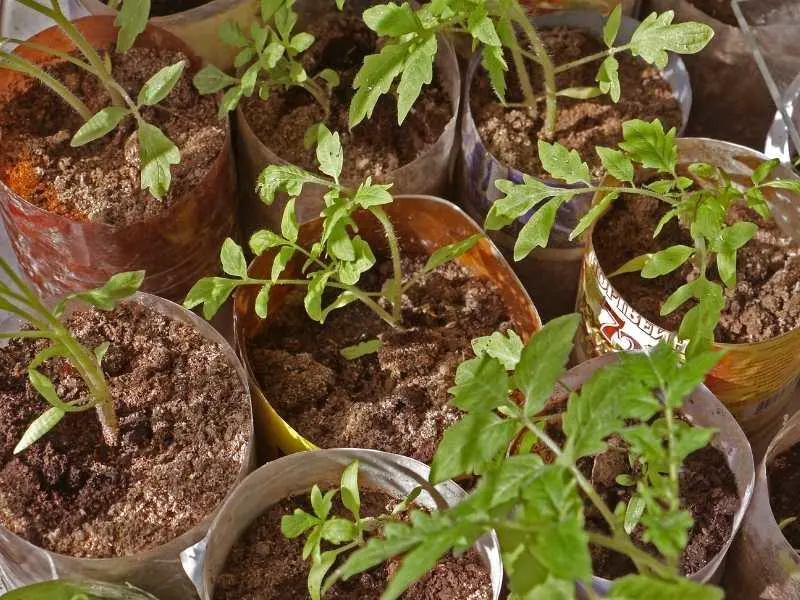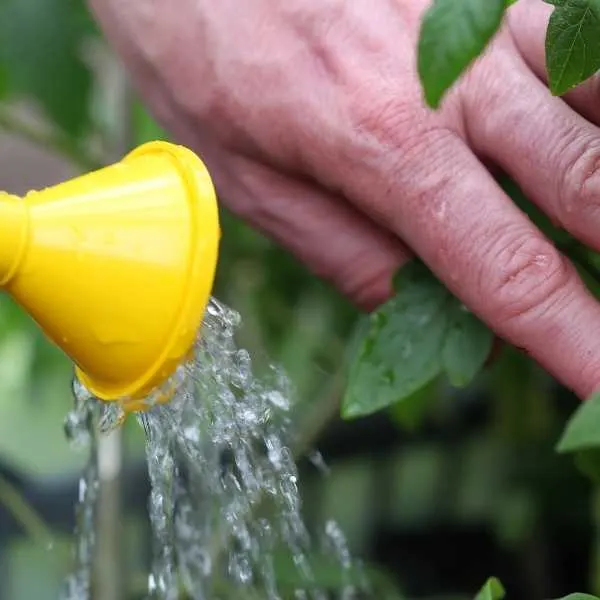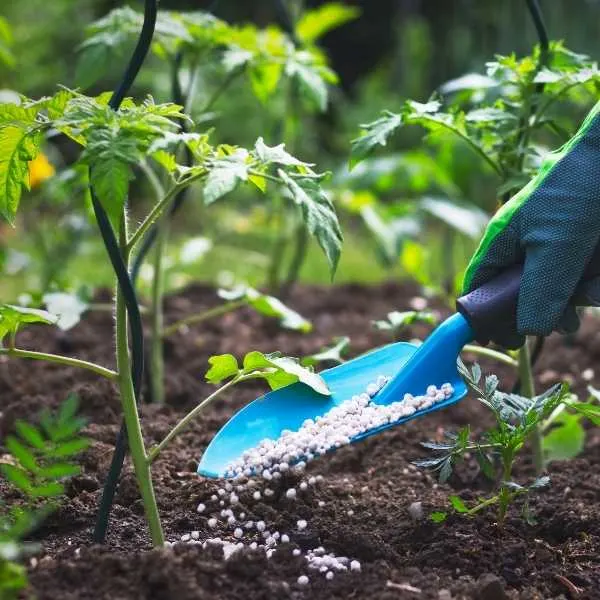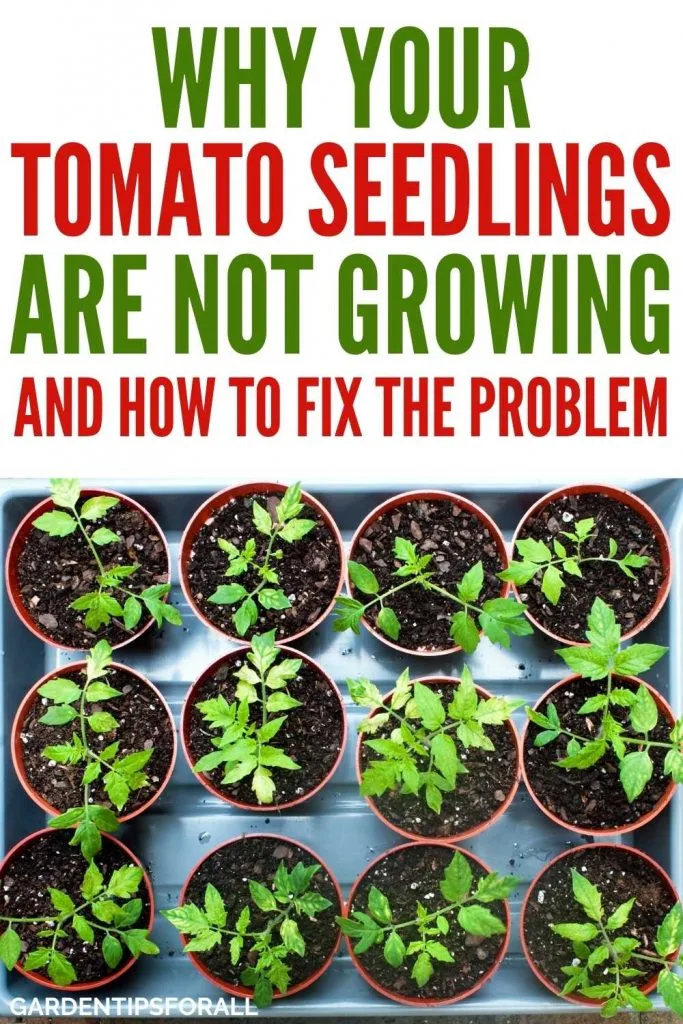My Tomato Seedlings are Not Growing – Why?
Nothing hurts more than planting tomatoes, or any other plants, only to see them stuck at a particular growth stage.
There are several reasons why your seedlings are not growing. These may include water issues, sunlight, nutrients, etc.
The first step should be to determine at what stage they stopped growing. After the seeds germinate above the soil, they produce (cotyledons) a small pair of leaves.
Then three weeks later, a set of true leaves grow from each seedling. So if they stopped growing at this point, then it means the growing conditions are not favorable.

Related Articles:
- Do You Have to Dry Tomato Seeds Before Planting?
- Tomato Plants Flowering But Not Fruiting – Why + Possible Fixes
Below are some of the reasons why your tomato seedlings may not be growing and how to fix the problem.
Top 3 Reasons Why Your Tomato Seedlings are Not Growing
#1. Too Much or Too Little Water

Too much water will stunt the seedling’s growth or even kill it since it causes the roots to rot.
Excess moisture also creates a favorable environment for fungi to thrive, and it even causes damping-off, a condition where tomato seedlings die immediately after emergence.
When you realize there’s too much water in your soil, give it some time to dry before watering again.
Inadequate watering also leads to poor growth and death of the seedlings. If the leaves seem discolored and the soil seems dry, it means that the seedlings are asking for more water.
How Often Should I Water Tomato Seedlings?
Tomato seedlings don’t need a lot of water, so you should water them sparingly. Provide uniform and deep watering to boost root growth.
The soil should feel wet to your touch but not soggy. You should also use clean tap water rather than stored rainwater for watering. This is because stored water may contain bacteria or fungi.
You should avoid watering your tomatoes overhead. Overhead watering only gets the leaves wet, but most of the water won’t get to the roots.
Instead, water the ground and let the roots absorb the water. You can also use a soaker hose to water the plants at a slow and consistent rate.
#2. Fertilizer Application

Over-fertilizing, or using the wrong fertilizer, may lead to spindly/leggy or dead seedlings. So make sure to use the right amounts as recommended by the manufacturer.
If you’re not sure about the ratio, start with a ¼ ratio and move up gradually as you monitor the results.
Timing is also another factor to consider. Plants need different nutrients at different stages of growth. And some seedlings may be too young for fertilizing.
It would be ideal to wait till your seedlings have about 2-3 pairs of leaves before fertilizing. You should also watch out for yellow or purple leaves, which are also indicators that you need to fertilize your seedlings.
Related: Is Cow Manure Good for Tomatoes?
What Is the Best Fertilizer for Tomato Seedlings?
Tomatoes thrive in well-drained soil, preferably with a lot of organic matter. The soil should also be slightly acidic with a pH of 6.0 -6.8.
It would be best to plant your seedling in a potting mix since the nutrients may be enough to support the plant for a couple of weeks.
Nevertheless, using the germ-free seed-starting vessel, like coconut coir or peat, might force you to give the plant some food.
Use one teaspoon of multipurpose fertilizer, such as the 15-30-15 fertilizer, diluted in 1 pint of water to feed the plant. The 15-30-15 is one of the best fertilizers for tomato seedlings.
Grow More 7415 Super Bloomer 15-30-15, 3-Pound
Two equally spaced applications of fertilizer usually are enough before transplanting the seedlings outside to a garden.
Fertilize cautiously as per the manufacturer’s instructions all through the life of the plant.
#3. Sunlight/Temperature
Leggy seedlings indicate that they’re not getting enough sunlight. They grow long and thin stems as they are stretching in search of light.
Conversely, temperature variations play a significant role in causing problems to the tomato seedling. If it’s too hot, you’ll have spindly seedlings.
And if it’s too cold, your seedlings may not survive. That’s why tomatoes are perennials in areas that experience frost. The ideal temperature should be 65-72 degrees Fahrenheit.
Related: Can Tomato Plants Recover from Frost Damage?
If it’s too hot, ensure your plants have enough air circulation. Lack of adequate air circulation is also likely to stimulate fungal growth.
Plant your seedlings with sufficient space in between to allow for enough airflow. When planting tomato seedlings indoors, a fan can help circulate more air, regulating the temperatures.
How Much Sunlight do Tomatoes Need?
You should give your seedlings at least 6 to 8 hours of direct sunlight. If you are growing the seedlings indoors, you can invest in LED grow lights.
EZORKAS 9 Dimmable Levels Grow Light for Indoor Plants VOGEK LED Growing Light Full Spectrum for Indoor Plants
VOGEK LED Growing Light Full Spectrum for Indoor Plants
Tomato Seedling Care Tips
Tomatoes aren’t that challenging to maintain. So if you don’t have much success on your first try, all hope is not lost. Below are some extra tips to follow to have a healthy and thriving tomato plant.
Pinch Back Your Tomato Seedlings
Pinching back tomato seedlings when they are 4-6 inches stimulates new growth. Since the plant is young and has not bloomed, doing this won’t affect any fruit growth.
The aim is to produce thick stems and dense foliage. For seedlings, pinch off the lowest two pairs of leaves before planting in the ground.
Cover the tomato plant to the point where you’ve pinched leaves to produce a denser and sturdier stem.
Move the Seedlings
Make sure the seedlings aren’t close to a walnut tree. Why? Walnuts produce juglone, a pollutant that goes into the soil and may kill neighboring plants.
Pests
Check the bottom of the tomato leaves for any pests that feed on tomato plants causing wilting such as red or green spider mites, caterpillars striped in purple and cream, or stalk borers.
Use insecticidal soap to kill spider mites.
Remove any visible stalk borers and give the plants extra care.
Herbicides
Keep lawn herbicides away from the tomato bed. When spraying in the yard to get rid of weeds and grass, herbicides are likely to blow onto the tomato seedlings and cause poor growth.
NOTE: In some cases, you may not be able to revive the seedlings, and disposing of them seems like the only option. Do not use any tomato seedlings that die of disease as compost as this may spread the plague. If leaves have turned yellow, the tomato plant is likely suffering from a bacterial infection and needs to be disposed of.
Conclusion
Tomatoes are no doubt one of the first vegetables that come to mind when you think of gardening. Perhaps it’s because of the pleasant and delicious fruits it can produce in a short time. As we’ve established, growing them isn’t that complicated, but a slight error in fertilizing, watering, or temperature can lead to stunted growth or death. All you have to do is identify the development stage they are in, diagnose the problem, and fix it with the tips I have detailed above.




